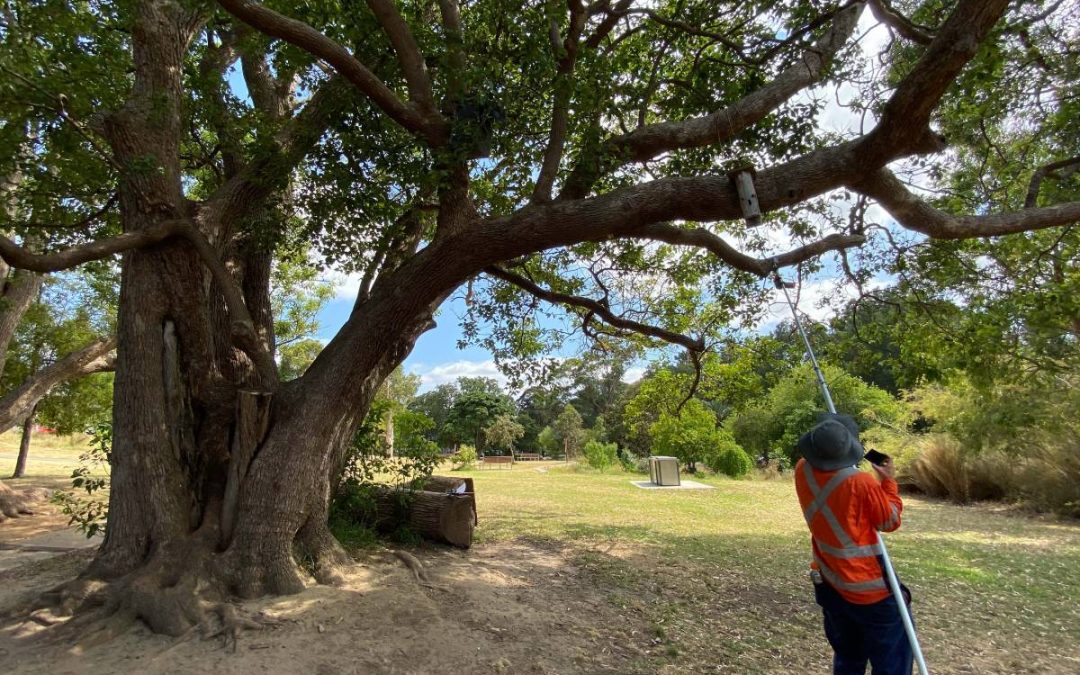Today is World Environment Day. This year’s theme is #TimeforNature. It’s a time to learn, take notice and take action for our environment.
Who is taking care of the 20 hectares of natural areas in the Inner West? Both Inner West Council staff and community members contribute to their maintenance to ensure a healthier future for humans and wildlife. We asked some of them to nominate their favourite places, what they do to look after them and what’s one action that anyone can take to care for nature.
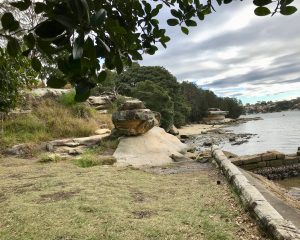
Deb Lennis, Cultural Advisor to the CEO, Inner West Council
I’m a proud D’harawal (saltwater) women, so therefore I’m drawn to salt water as a way to connect to my heritage. Callan Point in Callan Park for me has special meaning as it was where teaching took place before colonisation and still can continue today. My sadness about this spot is that many people/residents take this area for granted, without seeing its beauty, heritage and cultural significance to the Aboriginal community within the Inner West.
Down here at my favourite spot I work with all stakeholders (in Callan Park) to help make sure that the Point keeps its natural beauty. Benefits to nature is part of my culture and heritage, but also a big part of my work to keep the Council area looking the best it can where we all live in harmony. In my spare time I grow natives at home and have gardens that take little watering as Australia is the driest continent on Earth.
One action people can take: Well this is hard – we have only one Mother Earth/Nature so therefore, have respect (culture), learn (from past mistakes), understand (your surroundings) and plant (what was there before not introduced species).
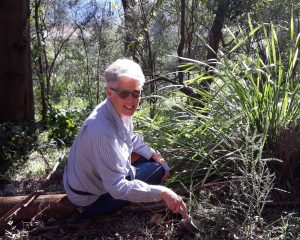
Angela Michaelis, Amy Large Senior Volunteer Award 2020, Vice-President Climate Change Balmain Rozelle
My favourite place is the patch of bushland recreated over many years from an old industrial site, the Balmain High slope. With a wooden walkway to take you from the water up to the back streets of Rozelle, it’s a rare natural space on the Balmain peninsula. As well as advocating for action to slow and eventually reverse the impacts of climate change I’ve been doing bushcare for about 25 years. Removing those plants-run-amok we call weeds allows our native plants a chance – although we also plant extra locals to increase biodiversity.
One action people can take: Join a bushcare group and enjoy the fresh air while you learn about our local flora. Balmain High Bushcare meets every 3rd and 4th Sunday of the month, 9 to 12.30, end of Bayville St, Balmain.
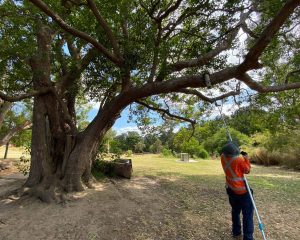
Nicole Gallahar, Senior Volunteers and Projects Officer Inner West Council
At Whites Creek Valley Park I am assisting one of our contractors, Narawan Williams from AMBS Ecology & Heritage, who is carefully inspecting a microbat box installed in a large tree with a camera on a long, flexible tube. Many species of birds, microbats, possums and other wildlife depend on tree hollows for roosting and breeding, but they are in short supply in our urban environment. Inner West Council enhances natural areas by installing nest boxes and creating hollows in dead trees (called stags or habitat trees) to give our wildlife more places to live.
I am developing Council’s Citizen Science program. In 2019, community members participated in ‘Inner West After Dark’ to survey frogs and microbats across Council’s wetlands and the ‘Early Birds’ Breakfast’, where we learnt how to do an Aussie Backyard Bird Count. Council supports Tempe Birdos and Greenway Birdos, who are collecting important data on birds in the Inner West, which we can use for conservation management.
One action people can take: I’d say to consider your backyard, balcony or park nearby as a little part of a network of habitat for our wildlife in the Inner West. If you make your backyard more friendly by planting native plants, including a bird bath or pond and creating shelter with rocks or fallen branches, wildlife will drop by and make your place part of their home range. What’s more, you can be a citizen scientist and record the birds, frogs, bandicoots and other wildlife you see at home or in your local area.
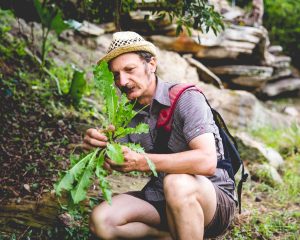
Diego Bonetto, wild foods educator
This is me with a dandelion by the Cooks River. I love this area because of its plant variety. There is always something to learn there as the saltwater and freshwater ecologies meet and clash with the land species. I am an environmental educator in my profession, I teach people how to identify species and how to see value in the landscape.
One action people can take: Start by putting names to things. Plant Blindness is a thing these days: the inability to see a plant because we do not have the name for it. I teach people how to identify and use plants for food or medicine. That is a great way to foster an appreciation for what nature has to offer.
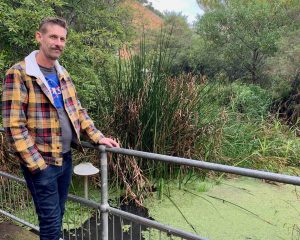
Darren Charlwood, artist and Aboriginal Education Programs Coordinator Royal Botanic Gardens Sydney
I love Whites Creek Wetland because it’s an example of biodiversity within an inner city environment, which is very rare these days. It’s a place where I feel like I can be anywhere other than a bustling city centre. I remember when I used to take refuge here when I lived in the Tony Mundine Hostel. It gives me a centred feeling and it draws on my connection to country even though it is far from my own country.
My approach to art and my cultural practice is based on the use of recycled materials which I can obtain within the urban environment. This practice draws on my Aboriginal tradition of only taking from the environment what I need to survive. I purposely seek out materials to use in my art that have been discarded or have been pre-loved. Within my current role at the Royal Botanic Gardens, I find myself in the unique position of delivering educational programs which highlight Aboriginal sustainable practice and the symbiotic relationship that we have as custodians of country.
On a personal level, I try to minimise my footprint as much as possible. At home I have created a small kitchen garden where we grow seasonal vegetables and have a worm farm. My family all gets involved in these activities and I have stressed to them the need to not only take care of country, but also to take care of the urban environment that we live in.
One action people can take: I think that the most important issue that we face right now is the amount of waste that we produce, not only as individuals but also on a global level. The amount of waste an individual household produces can be addressed by small changes to our shopping habits, like purchasing items with minimal packaging. And re-using things within the home. I believe this is an issue that needs to be taught from an early age to children in order for it to become the norm. We could easily shift the focus of our consumer mindset in order to assist in the healing of the environment.
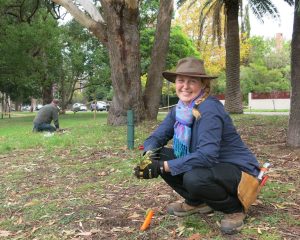
Tealia Scott, Senior Natural Areas and Contracts Officer, Inner West Council
Here we are hand weeding invasive grasses out, allowing space and light for native ground covers and sedges to grow from the existing seed bank.
Integrating natural processes to manage land in a restorative and regenerative way not only provides assisted growth of these rare species, but a living window into the rich biodiversity that existed here, pre-European invasion and colonisation, when humans co-evolved with nature for sustainable futures.
In my work I co-manage Council’s natural areas for increased biodiversity and ecological outcomes. Council manages specialised bush regeneration contractors and supports the dedicated work of the Mudcrabs and other community volunteers throughout our natural area sites. I assist them to maintain connection to local environments and achieve their grassroots goals. We care for and cultivate these natural areas which may appear a little wild or “overgrown” to the untrained eye, but are in fact important wildlife refuges and habitat havens, and unique and thriving eco-systems.
One action people can take: Spend time observing the natural process of things. We are nature and are obliged to have stewardship for the other animals and plants that are integral to a healthy ecological society. If someone could take time and reflect they may find practical approaches to living within their own ecological limits.
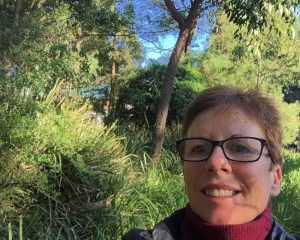
Jo Blackman, Inner West Environment Group
I love this bushcare site in Dulwich Hill as I can come and do my bush regeneration and it is always quiet, the air is clean and sweet, having extra oxygen and moisture given out by the trees. You can hear birds singing, spot blue tongue lizards and sometimes Tawny Frogmouths and if I’m very lucky Yellow-tailed Black-Cockatoos. You also make lots of new friends.
The Inner West Environment Group organises fortnightly bushcare working bees where we plant indigenous trees, shrubs and ground covers in pockets of disused railway land which are becoming part of the Cooks River to Iron Cove GreenWay. We create habitat for small animals, reptiles and birds, increasing biodiversity. IWEG also conducts bird surveys, especially looking for small birds which are disappearing from our cities.
One action people can take: Plant more native plants indigenous to our local area in our gardens. Plants are available at very reasonable prices from our community nurseries. They create habitat for our small animals and birds and they take less water and looking after.
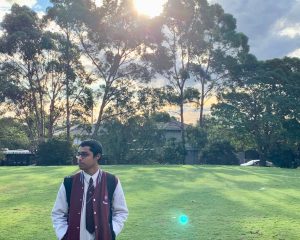
Rishabh Somani, 2020 Amy Large Youth Volunteer Award winner
Nature is a vital part of the atmosphere and vibe of a school. I love this natural place because it’s part of the nurturing character in the school. This place has seen everything from recreation to trivial behaviours. This place is part of the environment that makes it a school.
I have been inclined in raising awareness within and outside the school community and have been part of volunteering activities that help in cleaning communities. But recently, I have increased commitment towards the preservation of nature, and advance to increase my work towards sustaining the environment.
One action people can take: Caring for nature is looking after the only place humans can call home. There’s a lot that needs to be done, and a lot can be done by our numerous small actions. Simple steps, such as preservation of water, planting trees and minimising our carbon footprint. Or there could be complex steps, such as volunteering, educational campaigns, or large scale solutions to environmental problems.
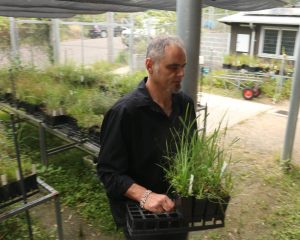
Adam Ward, Senior Ecology Volunteers and Projects Officer, Inner West Council
I’m at Rozelle Bay Community Native Nursery in Annandale. I’m collecting local native plants sown and grown by volunteers at the nursery in Annandale under the expert supervision of council’s botanical specialists. These plants or ‘tube stock’ will be planted and nurtured by bushcare volunteers and contractors at one of the community’s 38 bushcare sites or ‘natural areas’. These precious trees, shrubs and ground covers will provide habitat for our local native wildlife and threatened species.
One part of my role which I find particularly rewarding is working with Inner West students on natural area rehabilitation projects. These types of programs have positive environmental, social and educational outcomes. However, the real benefits become evident as the participants develop a custodial kinship with the nature.
One action people can take: There are many simple actions that we can all do to care for our local environment from growing a native plant to discussing or considering local wildlife. However, I feel that it is fundamental to reduce our personal consumption, waste and our ecological impact.
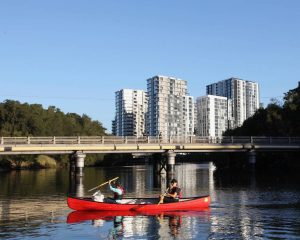
Bridget Cleaver, River Canoe Club
I love the Cooks River because of the immense joy and happiness it gives me. It is such a beautiful waterway, with its abundance of plant and animal life. It really nourishes the mind, body and soul. Over the years I have discovered the deep connection our First Nations people have and continue to have for the river. This only makes me love it even more. For many thousands of years it has given and continues to give so much to people. We are so lucky in the Inner West to have this beautiful waterway. It deserves so much of our love and respect.
I belong to a group of locals called “the Mullets”, part of the River Canoe Club (NSW) Marrickville. We kayak the river on a monthly basis picking up rubbish. Most months we collect over 12 huge bags of single use plastics and house hold waste.
One action people can take: Other than collecting rubbish along the Cooks River or any waterway, we must be mindful of our consumption of single use plastic. It is destroying the planet.
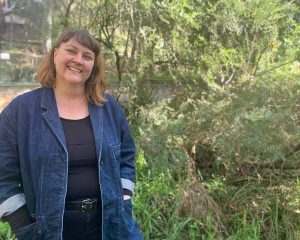 Kim Davies, outdoor education facilitator Seed Harvest Spoon
Kim Davies, outdoor education facilitator Seed Harvest Spoon
Cadigal Reserve in Summer Hill is where I first started as a bushcare volunteer 20 years ago and is part of the Greenway. I had just moved to Sydney from Brisbane and was keenly feeling the lack of green space in the Inner West. The place didn’t look like it does now, it was much barer. Places like the Greenway and Cooks River not only provide beautiful places to exercise and be in nature, but are extremely valuable habitat corridors, providing connection for birds and animals to travel between sites.
I facilitate outdoor classes in schools, encouraging students to observe and be more ‘literate’ about nature, starting with what’s in front of them, in their own school grounds. I’ve also been studying Conservation and Land Management and have become a casual bush regenerator.
One action people can take: Volunteer for a local bush care group – there are quite a few in the Inner West. You don’t have to have specific knowledge or skills, as there will be people to show you if you are open. Learn about the local native species of plants, learn to care for your local environment. Humans put a lot of pressure on the urban environment, so learning to think and act for other species is a valuable contribution that will benefit all for generations to come.
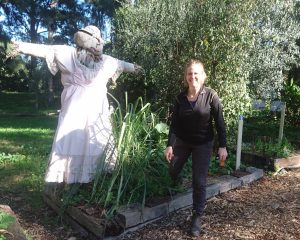
Tracy Graham, sustainable home designer and owner Connected Design
Wilkins Green is a school community garden that keeps me connected with the earth and community. Particularly when life is crazy. There are chickens, an edible garden and an in incredible bush land that makes me forget that I am so close to the city. A small inner city haven!!
I work as a building designer with a passion for sustainable building materials and buildings that perform well thermally.
One action people can take: I am obsessed about composting and I think if every household composted or had a worm farm we would go a long way in helping with waste and also improving our soils.

